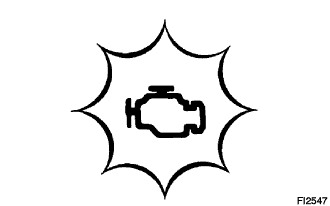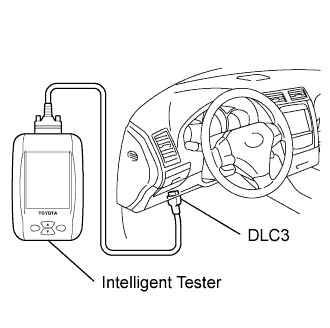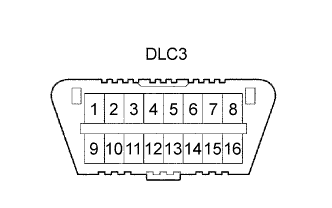Sfi System Diagnosis System
Engine. Lexus Gs430, Gs300. Uzs190 Grs190
DESCRIPTION
NORMAL MODE AND CHECK MODE
2 TRIP DETECTION LOGIC
FREEZE FRAME DATA
Data Link Connector 3 (DLC3)
BATTERY VOLTAGE
Malfunction Indicator Lamp (MIL)
Sfi System -- Diagnosis System |
EURO-OBD (EUROPE)
- When troubleshooting Europe On-Board Diagnostic (Euro-OBD) vehicles, the vehicle must be connected to an OBD scan tool (complying with ISO 15765-4). Various data output from the vehicle's ECM can then be read.
Euro-OBD regulations require that the vehicle's on-board computer illuminates the Malfunction Indicator Lamp (MIL) on the instrument panel when the computer detects a malfunction in:
The emission control system/components.
The power train control components (which affect vehicle emissions).
The computer.
In addition, the applicable Diagnostic Trouble Codes (DTCs) prescribed by ISO 15765-4 are recorded in the ECM memory
If the malfunction does not reoccur in 3 consecutive trips, the MIL turns off automatically but the DTCs remain recorded in the ECM memory.
To check DTCs, connect the intelligent tester or OBD scan tool to the Data Link Connector 3 (DLC3) of the vehicle. The scan tool displays DTCs, the freeze frame data and a variety of engine data.
The DTCs and freeze frame data can be erased with the scan tool (Click here).
M-OBD (EXCEPT EUROPEAN SPEC.)
- When troubleshooting Multiplex On-Board Diagnostic (M-OBD) vehicles, the vehicle must be connected to the intelligent tester. Various data output from the ECM can then be read.
OBD regulations require that the vehicle's on-board computer illuminates the MIL on the instrument panel when the computer detects a malfunction in:
The emission control system/components.
The power train control components (which affect vehicle emissions).
The computer.
In addition, the applicable DTCs are recorded in the ECM memory.
If the malfunction does not reoccur in 3 consecutive trips, the MIL turns off automatically but the DTCs remain recorded in the ECM memory.
| NORMAL MODE AND CHECK MODE |
The diagnosis system operates in normal mode during normal vehicle use. In normal mode, 2 trip detection logic is used to ensure accurate detection of malfunctions. Check mode is also available as an option for technicians. In check mode, 1 trip detection logic is used for simulating malfunction symptoms and increasing the system's ability to detect malfunctions, including intermittent problems (intelligent tester only).
- When a malfunction is first detected, the malfunction is temporarily stored in the ECM memory (1st trip). If the same malfunction is detected during the next subsequent drive cycle, the MIL is illuminated (2nd trip).
- Freeze frame data records the engine conditions (fuel system, calculated engine load, engine coolant temperature, fuel trim, engine speed, vehicle speed, etc.) when malfunctions are detected. When troubleshooting, freeze frame data can help determine if the vehicle was moving or stationary, if the engine was warmed up or not, if the air-fuel ratio was LEAN or RICH, and other data from the time the malfunction occurred.
| Data Link Connector 3 (DLC3) |
- The vehicle's ECM uses the ISO 15765-4 for communication protocol. The terminal arrangement of the DLC3 complies with SAE J1962 and matches the ISO 15765-4 format.
Symbols
| Terminal No.
| Names
| Reference terminal
| Results
| Condition
|
SIL
| 7
| Bus "+" line
| 5 - Signal ground
| Pulse generation
| During transmission
|
CG
| 4
| Chassis ground
| Body ground
| 1 Ω or less
| Always
|
SG
| 5
| Signal ground
| Body ground
| 1 Ω or less
| Always
|
BAT
| 16
| Battery positive
| Body ground
| 9 to 14 V
| Always
|
CANH
| 6
| CAN "High" line
| CANL
| 54 to 69 Ω
| Engine switch off
|
CANH
| 6
| CAN "High" line
| Battery positive
| 1 MΩ or higher
| Engine switch off
|
CANH
| 6
| CAN "High" line
| CG
| 1 kΩ or higher
| Engine switch off
|
CANL
| 14
| CAN "Low" line
| Battery positive
| 1 MΩ or higher
| Engine switch off
|
CANL
| 14
| CAN "Low" line
| CG
| 1 kΩ or higher
| Engine switch off
|
- HINT:
- Connect the cable of the intelligent tester to the DLC3, turn the engine switch on (IG) and attempt to use the intelligent tester. If the display indicates a communication error message, a problem exists on the vehicle side or the tester side.
- If communication is normal when the tester is connected to another vehicle, inspect the DLC3 on the original vehicle.
- If communication is still impossible when the tester is connected to another vehicle, the problem is probably in the tester itself. Consult the Service Department listed in the tester's instruction manual.
- Battery voltage:
- 11 to 14 V
- If voltage is below 11 V, replace the battery before proceeding.
| Malfunction Indicator Lamp (MIL) |
The MIL is illuminated when the engine switch is first turned on (IG) (the engine is not running).
The MIL should turn OFF when the engine is started. If the MIL remains illuminated, the diagnosis system has detected a malfunction or abnormality in the system.
- HINT:
- If the MIL is not illuminated when the engine switch is first turned on (IG), check the MIL circuit (Click here).



